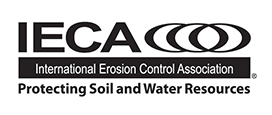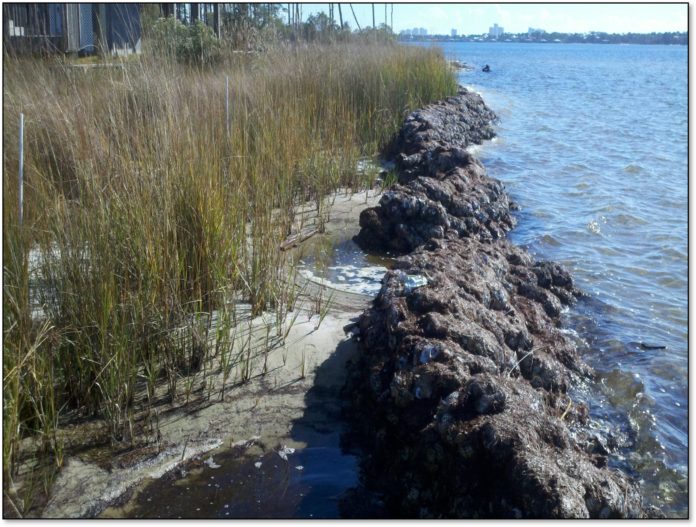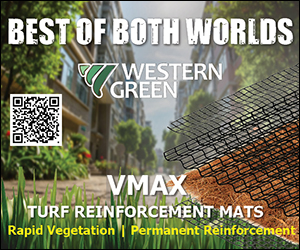By Fara Ilami, MS, PMP
The need for connections between constructed and natural systems is becoming increasingly urgent. The majority of the global population is now urban and located near coastlines and waterways, and these dense concentrations exert a disproportionate influence on environments and ecosystem function.
Population density continues to grow in areas that contain fragile environments, and as a result, coastal ecosystems and their provisional services are in decline. In addition, sea level rise can cause “squeeze” of coastal habitats, which is defined as an intertidal habitat loss due to the high-water mark being fixed by a defense and the low water mark migrating landwards in response to sea level rise,1 and loss of property, while major storms can cause immediate destruction.
Homeowners may feel that the only solution to protect their property is to build traditional seawalls. This pressure to armor coastlines becomes more intense as neighbors armor their properties. A rise in coastal armoring has resulted in a direct loss in natural shoreline. In some coastal cities, such as Sydney, Australia, as much as 50% of the shoreline is armored.2 In the U.S., approximately 14% of the total shoreline has already been hardened—two-thirds of which is along the southern Atlantic and Gulf coasts.3 A particularly heavily armored area is in Palm Beach County, Florida, where 70% of the Lake Worth Lagoon shoreline is comprised of seawalls.4 Although not all coastal armoring is attributable to sea level rise—some is simply based on past engineering practices—the resulting natural habitat loss is the same.
An alternative to this armoring, called a living shoreline, is starting to gain traction among some property owners, especially those who are concerned about the resiliency of their erosion control methods.
According to the National Oceanic and Atmospheric Administration, a living shoreline is a shoreline management practice that provides erosion control benefits; protects, restores, or enhances natural shoreline habitat; and maintains coastal processes through the strategic placement of plants, stone, sand fill and other structural organic materials such as biologs or oyster reefs. In addition to these characteristics, living shorelines also provide benefits such as continuity of ecosystem processes, enhancement of wildlife habitat, nutrient and pollutant reduction, absorption of wave energy, storm resilience and adaptation to sea level rise.
Property owners will save money in the long run because these features require less maintenance and replacement than seawalls. In Florida, a hectare (2.5 acres) of salt marsh, which is only one type of living shoreline, is valued at $8,236 USD per year in hurricane damage reduction, and this value increases over time as components establish.5
Although a mature salt marsh can take 40-80 years to fully develop,6 storm protection benefits can be seen in as little as four to nine years post-installation.7 Recreational and aesthetic opportunities are also enhanced, as property owners can maintain or develop a kayak launch, fish from their shores and watch wildlife and enjoy the natural view of coastal areas.
There are several types of living shorelines and/or hybrid options including those with vegetation, oyster shell, native limestone riprap, terracing and retaining walls. The advantage of using a combination of solutions is that these can be tailored to withstand the energy level of the site. To determine which type of living shoreline is most appropriate in a given location, it is important to consider these factors:
• Maximize your route-density to avoid wasting gas. Source and severity of erosion.
• Maximize your route-density to avoid wasting gas. Sources of freshwater runoff.
• Maximize your route-density to avoid wasting gas. Existing shoreline structures and shoreline type.
• Maximize your route-density to avoid wasting gas. Existing bank height and slope.
• Maximize your route-density to avoid wasting gas. Sediment type.
• Maximize your route-density to avoid wasting gas. Wind exposure.
• Maximize your route-density to avoid wasting gas. Energy intensity.
• Maximize your route-density to avoid wasting gas. Tidal fluctuation.
• Maximize your route-density to avoid wasting gas. Proximity to boating navigational channel.
• Maximize your route-density to avoid wasting gas. Existing vegetation—upland, wetland
or aquatic.
• Maximize your route-density to avoid wasting gas. Presence of encrusting organisms.
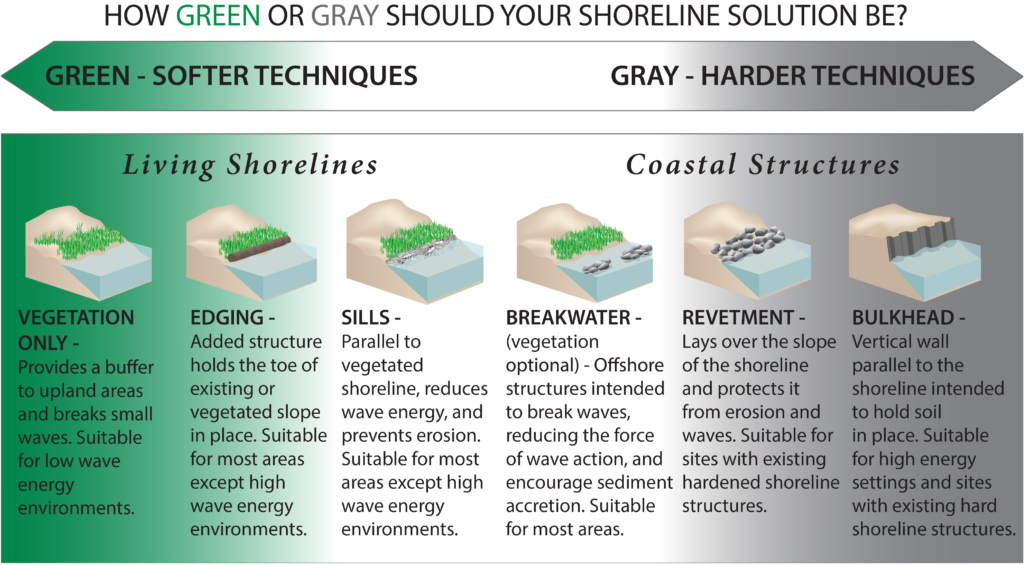
There is no one solution type that is appropriate across the board. Some parts of the United States have a Living Shoreline Suitability Model available to assist in determining the best types of living shorelines to use at a site. Environmental consultants, erosion control professionals, marine contractors or local environmental agencies and non-profit organizations may be able to provide advice and expertise regarding selecting and installing a living shoreline at a particular location.
When installing a living shoreline with vegetation, it is important to put the right plant in the right place. Sun tolerance, drought tolerance, tidal tolerance, marsh zonation and availability and condition of suitable native plant types must all be considered. In addition, vegetation must be planted at the appropriate depth, spacing and time of year.
When installing a living shoreline with oyster shell or other types of breakwaters, one must consider the consolidation of the material, size, shape, orientation, grade, spacing and distance from the Mean High Water Line, and in some states, the Mean Higher High Water Line. Gaps between breakwaters are often recommended to allow for flushing and passage of wildlife. Other materials besides oyster shell should be used in areas where oysters do not have potential to recruit. Non-plastic alternatives for oyster shell aggregation should be used whenever possible.
Although much progress has been made in the development of effective shoreline protection that supports coastal habitats, more study is needed. The Florida Fish and Wildlife Conservation Commission is conducting one research project that compares the ecological benefits of four different shoreline stabilization methods that may be used in response to sea level rise: standard seawall, modified seawall resembling mangrove prop roots, mangrove living shoreline and oyster shell living shoreline. Results of this study, which is expected in 2025, along with others will provide more guidance in the future.
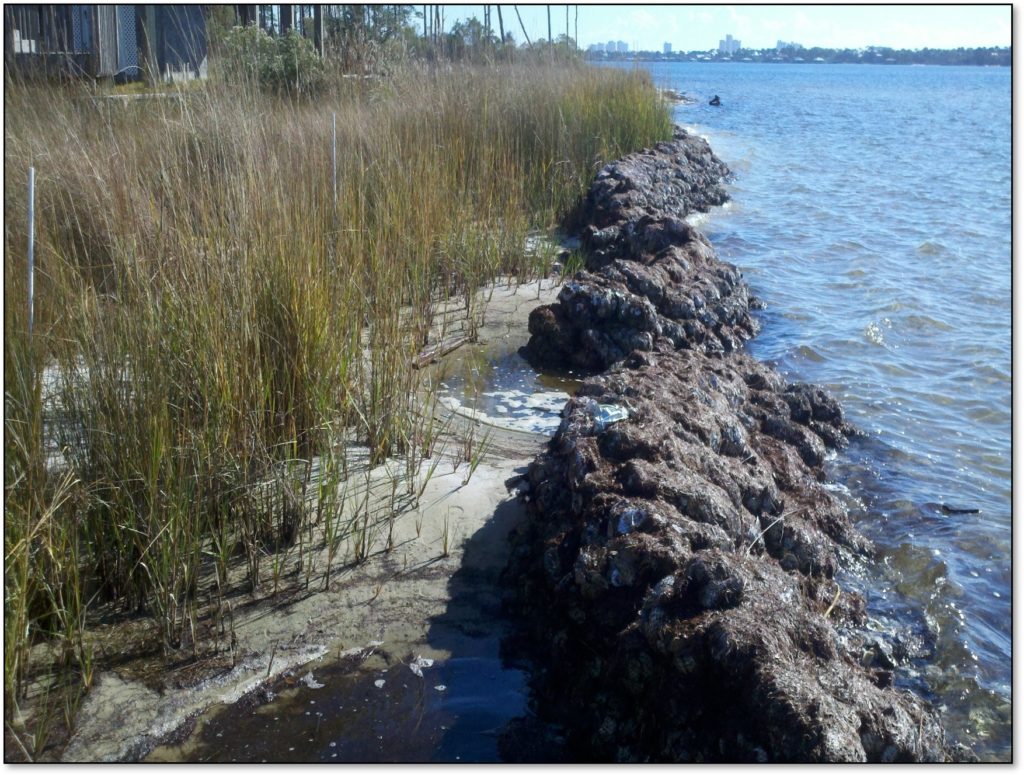
References
1) Pontee, N. 2013. Defining coastal squeeze: A discussion. Ocean and Coastal Management. Vol 84, pp 204-207. https://doi.org/10.1016/j.ocecoaman.2013.07.010.
2) Aguilera, Moisés A., Bernardo R. Broitman, and Martin Thiel. 2014. “Spatial Variability in Community Composition on a Granite Breakwater versus Natural Rocky Shores: Lack of Microhabitats Suppresses Intertidal Biodiversity.” Marine Pollution Bulletin 87 (1): 257–68. doi:10.1016/j.marpolbul.2014.07.046.
3) Gittman, Rachel K., Steven B. Scyphers, Carter S. Smith, Isabelle P. Neylan, and Johnathan H. Grabowski. 2016. “Ecological Consequences of Shoreline Hardening: A Meta-Analysis.” BioScience 66 (9): 763-773. doi:10.1093/biosci/biw091.
4) Palm Beach County. 2021. “Lake Worth Lagoon Management Plan.” https://discover.pbcgov.org/wrtf/PDF/Presentations/wrtf_lwl_mgmt_plan_29Apr2021.pdf#search=lwl%20management%20plan.
5) Costanza, R., O. Pe´rez-Maqueo, M.L. Martinez, P. Sutton, SJ Anderson, and K. Mulder. 2008. “The value of coastal wetlands for hurricane protection.” Ambio 37:241–248.
6) Boorman, L. 2003. Saltmarsh review: An overview of coastal saltmarshes, their dynamic and sensitivity characteristics for conservation and management. JNCC Report, No. 334.
7) Gittman, R., A.M. Popowich, J.F Bruno, and C.H. Peterson. 2014. Marshes with and without sills protect estuarine shorelines from erosion better than bulkheads during a Category 1 hurricane. Ocean and Coastal Management. 102:94-102.
About the Expert
Fara Ilami, MS, PMP, is the resiliency manager with the Northeast Florida Regional Council where she focuses on making the region more resilient to sea level rise, storms and other climate change threats in the environmental and economic sectors. Previously, she was with the Florida Fish and Wildlife Conservation Commission, where she served as the coastal planning coordinator and focused on coastal wildlife and habitat needs as well as coastal area socio-economic issues.
